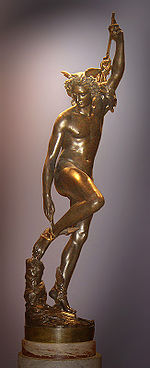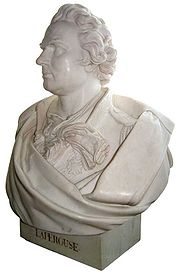
François Rude
Encyclopedia


France
The French Republic , The French Republic , The French Republic , (commonly known as France , is a unitary semi-presidential republic in Western Europe with several overseas territories and islands located on other continents and in the Indian, Pacific, and Atlantic oceans. Metropolitan France...
sculptor
Sculpture
Sculpture is three-dimensional artwork created by shaping or combining hard materials—typically stone such as marble—or metal, glass, or wood. Softer materials can also be used, such as clay, textiles, plastics, polymers and softer metals...
. He was the stepfather of Paul Cabet
Paul Cabet
Jean-Baptiste Paul Cabet , was a French sculptor. He was the pupil of François Rude, his stepfather...
, a sculptor.
Born in Dijon
Dijon
Dijon is a city in eastern France, the capital of the Côte-d'Or département and of the Burgundy region.Dijon is the historical capital of the region of Burgundy. Population : 151,576 within the city limits; 250,516 for the greater Dijon area....
, he worked at his father's trade as a stovemaker till the age of sixteen, but received training in drawing from François Devosges, where he learned that a strong, simple contour was an invaluable ingredient in the plastic arts In 1809 he went to Paris
Paris
Paris is the capital and largest city in France, situated on the river Seine, in northern France, at the heart of the Île-de-France region...
from the Dijon school of art, and became a pupil of Pierre Cartellier
Pierre Cartellier
Pierre Cartellier was a French sculptor.Born in Paris, he studied at the École Gratuite de Dessin in Paris and then in the studio of Charles-Antoine Bridan before attending the Académie Royale. During the French Revolution Cartellier was part of a team of sculptors who worked on the church of Ste...
, obtaining the Grand Prix de Rome
Prix de Rome
The Prix de Rome was a scholarship for arts students, principally of painting, sculpture, and architecture. It was created, initially for painters and sculptors, in 1663 in France during the reign of Louis XIV. It was an annual bursary for promising artists having proved their talents by...
in 1812. After the second restoration of the Bourbon
House of Bourbon
The House of Bourbon is a European royal house, a branch of the Capetian dynasty . Bourbon kings first ruled Navarre and France in the 16th century. By the 18th century, members of the Bourbon dynasty also held thrones in Spain, Naples, Sicily, and Parma...
s he retired to Brussels
Brussels
Brussels , officially the Brussels Region or Brussels-Capital Region , is the capital of Belgium and the de facto capital of the European Union...
, where, probably owing to the intervention of the exiled Jacques-Louis David
Jacques-Louis David
Jacques-Louis David was an influential French painter in the Neoclassical style, considered to be the preeminent painter of the era...
he got some work under the architect Charles Vander Straeten, who employed him to execute nine bas-reliefs in the palace of Tervuren
Tervuren
Tervuren is a municipality in the province of Flemish Brabant, in Flanders, one of the three regions of Belgium. The municipality comprises the villages of Duisburg, Tervuren, Vossem and Moorsel. On January 1, 2006, Tervuren had a total population of 20,636...
, now destroyed.

Sophie Fremiet
Sophie Fremiet was a French painter.Born in Dijon, her father was the assistant curator of the city's museum, a patron of artists and a fervent Bonapartist. Sophie was taught by Anatole Devosge, a former pupil of Jacques-Louis David...
, daughter of a Bonapartist compatriot to whom he had many obligations, but gladly availed himself of an opportunity to return to Paris, where in 1827 a statue of the Virgin for St Gervais and a Mercury fastening his Sandals (now in the Musée du Louvre) obtained much attention.
His great success dates, however, from 1833, when he received the cross of the Legion of Honour
Légion d'honneur
The Legion of Honour, or in full the National Order of the Legion of Honour is a French order established by Napoleon Bonaparte, First Consul of the Consulat which succeeded to the First Republic, on 19 May 1802...
for his statue of a Neapolitan Fisher Boy playing with a Tortoise (now in the Louvre), which also procured for him the important commission for all the sculptural frieze ornament and one group on the Arc de Triomphe
Arc de Triomphe
-The design:The astylar design is by Jean Chalgrin , in the Neoclassical version of ancient Roman architecture . Major academic sculptors of France are represented in the sculpture of the Arc de Triomphe: Jean-Pierre Cortot; François Rude; Antoine Étex; James Pradier and Philippe Joseph Henri Lemaire...
, in Paris
Paris
Paris is the capital and largest city in France, situated on the river Seine, in northern France, at the heart of the Île-de-France region...
. This group, Départ des volontaires de 1792 (Departure of the Volunteers of 1792), also known as La Marseillaise
La Marseillaise
"La Marseillaise" is the national anthem of France. The song, originally titled "Chant de guerre pour l'Armée du Rhin" was written and composed by Claude Joseph Rouget de Lisle in 1792. The French National Convention adopted it as the Republic's anthem in 1795...
, a work full of energy and fire, immortalizes the name of Rude.
Among other productions are Napoleon
Napoleon I of France
Napoleon Bonaparte was a French military and political leader during the latter stages of the French Revolution.As Napoleon I, he was Emperor of the French from 1804 to 1815...
Awakening to Immortality (Musée d'Orsay
Musée d'Orsay
The Musée d'Orsay is a museum in Paris, France, on the left bank of the Seine. It is housed in the former Gare d'Orsay, an impressive Beaux-Arts railway station built between 1898 and 1900. The museum holds mainly French art dating from 1848 to 1915, including paintings, sculptures, furniture,...
, Paris), the statue of the mathematician Gaspard Monge
Gaspard Monge
Gaspard Monge, Comte de Péluse was a French mathematician, revolutionary, and was inventor of descriptive geometry. During the French Revolution, he was involved in the complete reorganization of the educational system, founding the École Polytechnique...
(1848), Jeanne d'Arc, in the gardens of the Luxembourg (1852), a Calvary in bronze
Bronze
Bronze is a metal alloy consisting primarily of copper, usually with tin as the main additive. It is hard and brittle, and it was particularly significant in antiquity, so much so that the Bronze Age was named after the metal...
for the high altar of St Vincent de Paul
Saint-Vincent-de-Paul church, Paris
The Church of Saint-Vincent-de-Paul is a church in the 10e arrondissement of Paris dedicated to Saint Vincent de Paul. It gives its name to the Quartier Saint-Vincent-de-Paul around it.-History:...
(1855), as well as Hebe and the Eagle of Jupiter (Musée des Beaux Arts, Dijon
Dijon
Dijon is a city in eastern France, the capital of the Côte-d'Or département and of the Burgundy region.Dijon is the historical capital of the region of Burgundy. Population : 151,576 within the city limits; 250,516 for the greater Dijon area....
), Love Triumphant and Christ on the Cross, all of which appeared at the Paris Salon
Paris Salon
The Salon , or rarely Paris Salon , beginning in 1725 was the official art exhibition of the Académie des Beaux-Arts in Paris, France. Between 1748–1890 it was the greatest annual or biannual art event in the Western world...
of 1857 after his death.

Jean-Baptiste Carpeaux
Jean-Baptiste Carpeaux was a French sculptor and painter.Born in Valenciennes, Nord, son of a mason, his early studies were under François Rude. Carpeaux entered the Ecole des Beaux-Arts in 1844 and won the Prix de Rome in 1854, and moving to Rome to find inspiration, he there studied the works of...
, who subsequently executed his own interpretation of a Neapolitan Fisher Boy, a popular subject at the time).
The Musée Rude, Dijon, inaugurated in 1947, is devoted to plaster casts of his works that were acquired by the city of Dijon, between 1887 and 1910; it is housed in the transept of the 11th-century church of Saint-Etienne in rue Vaillant.
External links
- Louvre Database (French language) - Works by Rude (and some others)
- More views of the Neapolitan Fisherboy
- Views of the Arc de Triomphe
- Art on-line: François Rude
- French language site listing works by Rude, with access to large images (it may be necessary to close an advertising banner to view this page)

